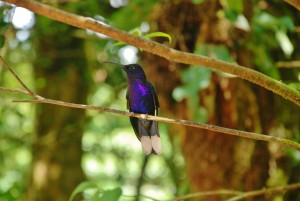Hummingbirds are typically between 3-5 inches tall, which makes them some of the smallest species of birds. Hummingbirds have the highest metabolism of any animal that is not an insect. These birds must have a high metabolism to support their rapid wing movement and extremely high heart rate (typically around 1000 beats per minute). The rapid wing movement allows hummingbirds to hover and fly backwards, which no other bird is able to do.
Hummingbirds are able to drastically lower their metabolism rate at night or if they are having trouble finding food. They induce themselves into a deep sleep state, almost like a mini hibernation. This state is known as torpor, and it can lower a hummingbird’s heart rate to just 50 to 180 beats per minute. Torpor also leads to a weight loss of about 10% body weight overnight.

A perched violet sabrewing, photo courtesy of Lewis Kim
Hummingbirds contain special cells in their feathers that act like prisms when sunlight hits. The sunlight is split into wavelengths, which are reflected back giving iridescent colors. Some hummingbirds use these bright colors as a territorial warning. For example, the head of a hummingbird may be brown and dull from an indirect angle. If the hummingbird were to fly at an enemy head on, it would display a bright color as a way to intimidate the other bird.

